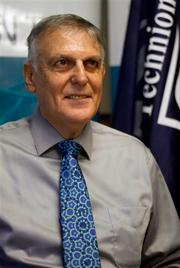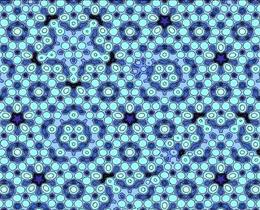Published online 5 October 2011 | Nature | doi:10.1038/news.2011.572
News
Impossible crystals snag chemistry Nobel
Daniel Shechtman takes award for doggedly pursuing quasicrystals.
 Daniel ShechtmanAP Photo/Ariel Schalit
Daniel ShechtmanAP Photo/Ariel SchalitDaniel Shechtman of the Technion Israel Institute of Technology in Haifa was awarded the prize for his 1982 discovery1 of quasicrystals: materials with a mosaic-like, never-quite-repeating atomic structure that defied the textbooks of the time, existing only as mathematical curios. "It took an enormous amount of courage for Danny to stick to his claim," says Veit Elser, a physicist at Cornell University in Ithaca, New York.
It took two years for Shechtman to get his discovery published. His work was scorned by luminaries including double-Nobel-prizewinning chemist Linus Pauling, but after it was published, other examples of the crystals flooded in from around the globe. In 2009, researchers reported finding the quasicrystal structure in an alloy of aluminium, copper and iron, acquired by an Italian museum in 1990 but reported to have come from 200-million-year-old rocks in the Koryak Mountains in Russia2.
"This is an award that we've been expecting for 25 years now — I've been sending a recommendation letter to the Nobel committee every year," says Jean-Marie Dubois, who studies complex metallic alloys at the University of Nancy, France.
It still isn't clear how atoms assemble into quasicrystal structures, and the discovery has so far found few real-world applications. But the quasicrystals do have unusual and potentially useful physical properties. Although many quasicrystals are metallic alloys, they do not behave like metals: thanks to the way their electrons are confined, they are poor at conducting heat and electricity, and have non-stick surfaces, so they might be useful in low-friction coatings for frying pans. They are also very hard, and can be used to improve the strength of materials such as steel. But it is not clear that materials incorporating quasicrystals will be more useful than others currently on the market, says Ronan McGrath, a surface scientist at the University of Liverpool, UK.
Instead, Shechtman's key contribution to chemistry was in opening scientists' eyes to the possibility of new forms of matter. "The discovery of quasicrystals has taught us humility," writes Sven Lidin, an inorganic chemist at Stockholm University and a member of the Nobel Committee for Chemistry.
Fearful symmetry
 This atomic model of a silver-aluminium quasicrystal shows its mosaic pattern.Ames Laboratory
This atomic model of a silver-aluminium quasicrystal shows its mosaic pattern.Ames LaboratoryOn 8 April 1982, Shechtman, who was on sabbatical at the US National Bureau of Standards (now the National Institute of Standards and Technology; NIST) in Gaithersburg, Maryland, found that an artificial alloy of aluminium and manganese disobeyed the rules.
When he shot electrons through the material, they created a regular diffraction pattern, proving that the material's atomic structure consisted of orderly repeating elements. But that pattern showed a forbidden pentagonal symmetry — it could be rotated by both one-tenth and one-fifth of a full circle and would still look the same. In his laboratory notebook for that day, Shechtman wrote: "10 Fold???"
"There can be no such creature," he is reported to have said. Others did their best to persuade him that his discovery was wrong. "I told everyone who was ready to listen that I had a material with pentagonal symmetry. People just laughed at me," Shechtman told Haaretz magazine in a profile earlier this year. He was asked to leave his research group, he says.
But Shechtman got his findings published in November 1984 in Physical Review Letters, with the help of Ilan Blech, a materials scientist at Technion, John Cahn, a physicist at NIST, and Denis Gratias, a crystallographer then at the Centre for Metallurgic Chemistry in Vitry, France. "All I did was present the wonderful work that he had done in a compelling way," Cahn says.
When the paper did come out, recalls Elser, "everybody was incredulous. This was what the textbooks had told them wasn't possible." Researchers around the world rushed to confirm the findings. Like Shechtman, they melted alloys of aluminium and manganese and put them onto a cold surface. The same diffraction pattern emerged.
"Given the relative simplicity of making these materials, it's certain that the five-fold patterns had been seen by numerous scientists before Shechtman, who dismissed them because they didn't fit the rigid rules of crystallography," says Elser.
Indeed, such 'aperiodic' five-fold structures had been described by mathematicians many decades before — most famously by British mathematician Roger Penrose. Related complex designs are found in Islamic art and architecture.
"Breaking the symmetry laws that we as crystallographers are educated on was difficult to accept," says Ada Yonath, a crystallographer based at the Weizmann Institute of Science in Rehovot, Israel, who won the Nobel Prize in Chemistry in 2009 for her work on the structure of the ribosome. "Though [Shechtman] is such a nice man I would work with him even if I disagreed with him."
No comments:
Post a Comment